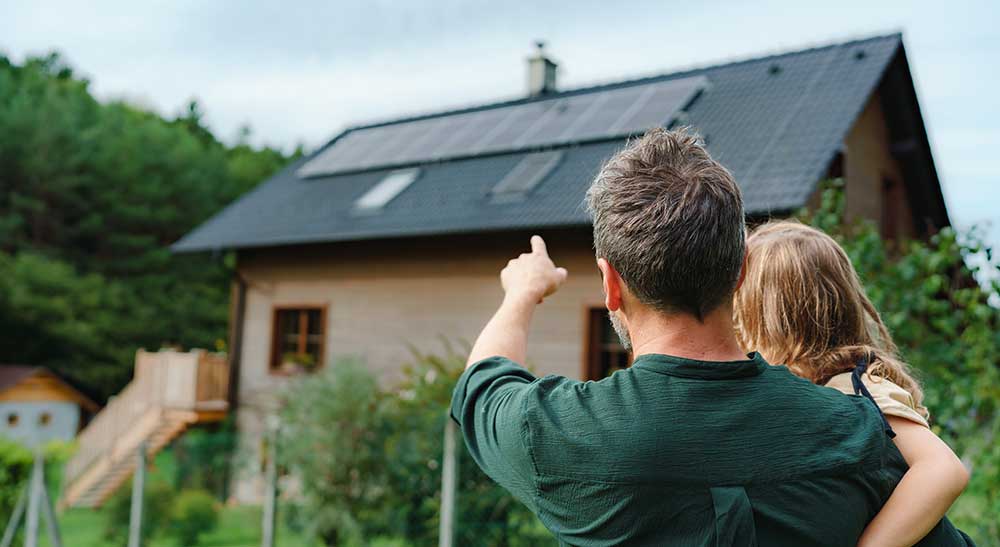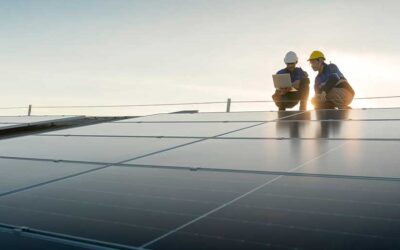Residential and commercial buildings play a significant role in global energy consumption. They account for nearly 40% of total energy use and 36% of CO2 emissions worldwide. This startling statistic underscores the urgency of adopting sustainable practices in our homes and offices.
But energy isn’t the only concern. Offices, in their daily operations, generate a staggering amount of waste. From paper to plastic, the waste produced often ends up in landfills, contributing to environmental degradation. To put it in perspective, an average office worker uses 10,000 sheets of copy paper each year. Multiply that by the number of office workers globally, and the magnitude of the problem becomes evident.
Households, too, leave a significant carbon footprint. The average household emits about 6.8 metric tons of CO2 annually, primarily from energy consumption. This figure can vary based on the country, but the message is clear: households play a pivotal role in global carbon emissions.
The numbers paint a vivid picture of the challenges we face. But they also highlight the immense opportunity for change. We can significantly reduce our environmental impact by making small, sustainable choices in our homes and workplaces. The journey towards a sustainable future begins with understanding the imperative of change.
Energy Efficiency: The First Step
With the increasing demand for energy and the growing concern for our planet’s well-being, making our homes and offices more energy-efficient is a step in the right direction.
Why Switch to Energy-Efficient Appliances?
The Bureau of Energy Efficiency highlights the importance of using energy-efficient appliances. Not only do they consume less power, but they also reduce greenhouse gas emissions and decrease our carbon footprint. Over time, these appliances can lead to significant savings on energy bills, making them a win-win for both the environment and our wallets.
Shedding Light on LED Lighting
One of the simplest ways to enhance energy efficiency is by switching to LED lighting. Compared to traditional bulbs, LEDs consume up to 85% less energy and last up to 25 times longer. Moreover, they don’t contain harmful substances like mercury, making them environmentally friendly. The lighting energy efficiency trend has surged, with more homeowners and businesses switching.
Smart Thermostats: The Future of Heating and Cooling
Gone are the days when thermostats were mere temperature-setting devices. Modern smart thermostats learn from our habits and adjust the temperature accordingly, ensuring optimal comfort while saving energy. These devices can determine when to heat or cool a space by analyzing patterns, preventing unnecessary energy consumption.
The Bigger Picture
The journey towards energy efficiency is not just about reducing costs; it’s about creating a sustainable future. By adopting energy-efficient practices, we’re preserving our planet’s resources and setting a precedent for future generations. As more individuals and businesses recognize the importance of energy efficiency, it becomes a collective effort towards a brighter, greener future.
Water Conservation: Every Drop Counts
Water is the essence of life, and conserving it is not just an environmental responsibility but a necessity for survival. With increasing global water scarcity, homes and offices must adopt measures that ensure every drop is used judiciously.
The Power of Low-Flow Fixtures
Low-flow fixtures, such as faucets, showerheads, and toilets, have been designed to use significantly less water than their traditional counterparts. For instance, a standard showerhead might use up to 5 gallons of water per minute, while a low-flow version uses just 2.5 gallons or less. Over a year, this can result in thousands of gallons saved, translating to both environmental benefits and cost savings on water bills.
Harvesting Rain, the Nature’s Gift
Rainwater harvesting systems are a brilliant way to utilize nature’s free resources. Collecting and storing rainwater in homes and offices can reduce their reliance on municipal water supplies. This stored water can be used for gardening, flushing toilets, and even laundry after proper treatment. Moreover, harvesting rainwater reduces runoff, which can lead to erosion and water pollution.
Planting for the Future
Landscaping plays a pivotal role in water conservation. Opting for drought-resistant plants reduces the need for frequent watering and ensures a green space even in dry conditions. Plants like succulents, lavender, and sage are beautiful and champions in water conservation.
Top 5 Water-Saving Tips for Homes and Offices
- Fix leaks promptly. A dripping tap can waste more than 1,000 gallons of water a year.
- Install aerators on faucets to reduce the flow without compromising on water pressure.
- Use a broom instead of a hose to clean driveways and sidewalks.
- Water plants early or late in the evening to reduce evaporation.
- Consider using a rain barrel to collect water for outdoor use.
Water conservation is about saving water and creating a sustainable future. By adopting simple measures and being mindful of our water usage, we can make a significant difference in preserving this precious resource for future generations.
Waste Management: Reduce, Reuse, Recycle
With landfills reaching their capacity and oceans brimming with plastic, the need for effective waste management solutions is more pressing than ever. But what if the answer lies in managing waste and reducing it?
The Three R’s – A Sustainable Mantra
Reduce, reuse, and recycle, often called the three R’s, form the cornerstone of sustainable waste management. These principles guide individuals and businesses toward a more sustainable future.
1. Reducing Consumption
The first step towards sustainable waste management is to reduce consumption. By being mindful of what we buy and use, we can significantly decrease the waste we produce. Opting for products with minimal packaging, buying in bulk, and choosing durable items over disposable ones are just a few ways to reduce waste at the source.
2. Reusing – Giving Items a Second Life
Before discarding an item, consider if it can be reused. Old jars can be repurposed as storage containers, worn-out clothes can be transformed into cleaning rags, and cardboard boxes can be used for organizing. Finding new purposes for old items reduces waste and saves money and resources.
3. Recycling – Turning Waste into Resources
Recycling is the process of converting waste materials into new products. Many materials can be recycled, from paper and glass to metals and plastics. By segregating waste at the source and ensuring that recyclables reach the appropriate facilities, we can help reduce the strain on landfills and contribute to a circular economy.
The Bigger Picture – Beyond the Three R’s
While the three R’s provide a solid foundation for sustainable waste management, there’s more to the story. Upcycling, for instance, is a creative way to transform waste materials into valuable products. By adding value to discarded items, upcycling not only reduces waste but also promotes innovation and creativity.
Moreover, businesses can play a pivotal role in promoting sustainable waste management. Businesses can positively change the waste management landscape by adopting eco-friendly packaging, implementing take-back programs, and encouraging consumers to make sustainable choices.
Sustainable Materials: Building for the Future
The focus is moving from merely erecting structures to building with a conscience. Sustainable materials are at the forefront of this change, offering both environmental benefits and modern elegance to homes and offices.
Bamboo – Nature’s Steel
Bamboo, often called ‘nature’s steel,’ is remarkable. It’s not just about its rapid growth; bamboo boasts strength comparable to steel and flexibility that most construction materials can’t match. This makes it an excellent choice for flooring, furniture, and structural elements.
Reclaimed Wood – Beauty from the Past
There’s a certain charm in using wood that has a history. Reclaimed wood, sourced from old barns, warehouses, and bridges, reduces the demand for new timber and brings a rustic aesthetic appeal to interiors. Each plank tells a story, adding depth and character to spaces.
Eco-friendly Insulation – Warmth without the Waste
Traditional insulation materials can be a source of pollutants. However, sustainable alternatives like sheep’s wool, recycled denim, and cellulose provide effective insulation without compromising indoor air quality. They are biodegradable, reducing their environmental impact at the end of their life cycle.
Green Roofs and Walls – Living Architecture
Imagine a building that breathes, cools itself naturally, and even offers a habitat for birds and insects. Green roofs and walls make this possible. These living systems enhance a building’s thermal performance and contribute to urban biodiversity. They act as natural air purifiers, improving our air quality.
Cork and Linoleum – Resilient and Renewable
Regarding flooring options, cork, and linoleum stand out for their sustainability. Cork is a renewable resource, harvested from the bark of oak trees without causing any harm. Linoleum, made from natural materials like linseed oil and jute, is biodegradable and lasts up to 40 years.
Incorporating these materials into homes and offices is more than just a trend; it’s a testament to a global movement toward sustainability. By choosing sustainable building materials, individuals and businesses can play a pivotal role in reducing the environmental impact of construction and paving the way for a greener future.
Technology: Smart Solutions for Sustainability
The rise of smart homes and offices is undeniable. These spaces are equipped with interconnected devices that can be controlled remotely, offering unparalleled convenience. But beyond the allure of controlling your thermostat from your smartphone, there’s a more profound, more impactful advantage. Smart systems can monitor energy consumption in real time, allowing homeowners and businesses to identify wasteful practices and make informed decisions. For instance, a smart thermostat can learn a user’s schedule and adjust heating or cooling, ensuring optimal energy use.
Harnessing the Power of IoT
The Internet of Things (IoT) is pivotal in driving sustainability. With sensors and devices communicating, monitoring and managing resource consumption is easier than ever. Imagine a refrigerator that can alert you when food is about to expire, reducing waste. Or an office lighting system that dims when natural light is abundant, conserving electricity. The possibilities are vast, and the environmental benefits are significant.
Solar Panels and Renewable Energy
While technology inside the home is evolving, so too are the sources of energy that power them. Solar panels have become more affordable and efficient, making them a viable option for many households and businesses. By harnessing the sun’s energy, homes and offices can reduce their reliance on non-renewable sources, reducing carbon emissions. Moreover, with advancements in battery storage, excess energy generated during sunny days can be stored for use during cloudy days or nighttime.
Investing in Green Pays Off
When it comes to sustainability, many individuals and businesses hesitate, considering the initial costs associated with green initiatives. However, what’s frequently overlooked is the long-term financial benefits these sustainable practices bring. Delving into the financial aspect of sustainability, it becomes evident that the return on investment (ROI) is not just about saving the planet; it’s also about saving money.
Savings in the Long Run
One of the most compelling arguments for adopting sustainable practices is the long-term savings they offer. For instance, while installing solar panels or energy-efficient appliances might require a significant upfront investment, the savings on monthly utility bills can quickly offset these costs. Over time, as energy prices continue to rise, these savings become even more pronounced.
Furthermore, sustainable homes and offices often have a higher resale value. Features like solar panels, energy-efficient windows, or green roofing can significantly increase a property’s market value. Today’s Buyers and renters are more environmentally conscious and willing to pay a premium for properties that incorporate sustainable features.
Tax Breaks and Incentives
Governments worldwide recognize the importance of sustainability and often provide tax breaks, rebates, and incentives to encourage individuals and businesses to adopt green practices. This could mean tax credits for installing solar panels or energy-efficient appliances for homeowners. For businesses, there might be rebates for retrofitting offices with LED lighting or incentives for adopting sustainable manufacturing processes.
These financial incentives reduce the initial cost of adopting sustainable practices and enhance the ROI, making green initiatives even more appealing financially.
Sustainable Business Practices and Profitability
For businesses, sustainability isn’t just about being environmentally responsible; it’s also about profitability. Companies that adopt sustainable practices often see a boost in their brand image, leading to increased customer loyalty and sales. Moreover, sustainable businesses often have lower operational costs due to reduced waste and energy consumption.
A Harvard Business School study found that companies prioritizing sustainability outperform those that don’t in the long run. These companies see higher profit margins, better stock performance, and increased shareholder value.
The Bigger Picture
While the financial benefits of sustainability are evident, it’s essential to remember the broader impact. Every sustainable practice adopted contributes to a healthier planet, ensuring a better future for future generations. In this case, the ROI isn’t just measured in monetary terms but also in the environment’s and society’s well-being.
In conclusion, when considering the financial aspect of sustainability, it’s clear that green initiatives are not just an expense but an investment. An investment that offers significant returns, both financially and environmentally. Whether you’re an individual homeowner or a business, the message is clear: investing in green pays off.




